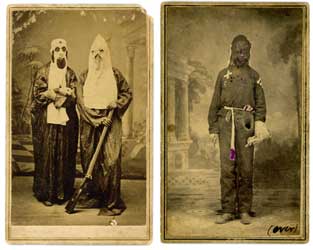

|
 The makers’ imprint on the back of each of these two photographs reads: “Robinson and Murphy, Artists, No. 4 Bank Row, Huntsville, Ala” (click on the image to see an enlargement). There is also a handwritten note in period pen that reads as follows: “Photograph of uniforms etc taken by Lt. L. E. Campbell 38th NY on the night of the 31st of October, 1868 ― these were worn by Ku Klux on the night of the fight.” The “fight” mentioned here was a raid on Huntsville, Alabama on Oct. 31, 1868 by approximately 150 mounted men, all wearing Ku Klux Klan regalia and armed with pistols, shotguns, and other other weapons. The 1868 report of the Joint Committee on Outrages, compiled and published to record the increasing activities of the KKK, describes how the raiders came to town to break up a meeting of the Republican Party and to intimidate the now free Blacks of the region. Following is an excerpt from the testimony of A. J. Applegate, a witness to the raid: “About 10 o’clock, the excitement in the meeting and around the court house, became very great. I could hear from all quarters that the Ku Klux were com- ing. I walked down in front of the court house, and saw the head of the column coming up the street, on the east side of the square. They were riding three and four abreast. Their horses were covered with white sheets. The members wore gowns made of light colored material, with masks, hideously ornamented. Each horseman had from one to two pistols, one of which was carried in his right hand, cocked ; also, a carbine or double-barreled shot gun. The column consisted of about one hundred and fifty men. As they passed around the square, I passed through the hall of the court house, crossed the street ahead of the column. When I came out of the court house yard, I saw large crowds of the white citizens stand- ing in groups, or running to and fro, and a considerable number of negroes, who seemed worked up to a state of perfect phrenzy with fear.” The KKK raiders shot Judge Thurlow, who died of his wounds, as well as two African American men, also killed, and wounded several more. Citizens of Huntsville sent to a nearby Federal army camp for protection. That evening, Lieutenant Campbell’s patrol caught three mounted men with weapons and KKK robes in their saddle bags, arrested them, and confiscated the weapons and regalia. But the local authorities released them from prison the next morning; with the help of local citizens, they rearmed, took back their horses by force, and escaped. There seems to have been no other consequences for the attackers. The men in the two photographs are therefore not members of the Ku Klux Klan. They are Federal soldiers who have put on the confiscated robes to record them with a photographer as part of an effort to document the practices of the KKK. These are then very early examples of documentary or forensic photography. According to the Arlington National Cemetery Website, Lieutenant Lafayette E. Campbell (1845-1919) was a career soldier who entered the military as a private in 1862 and rose to the rank of first lieutenant by the end of the Civil War. In 1875, Campbell married Margaret Lynd Dent, the daughter of General Frederick Tracy Dent, who was the brother-in-law of President Ulysses Simpson Grant. In the late 1880’s, Captain Campbell served as quartermaster overseeing the construction of Fort Logan, Denver, Colorado. He retired at the rank of Lieutenant Colonel. Another on-line sourcefor Campbell is the Friends of Historic Fort Logan. |